I had the opportunity to sit down with Jon Shafer of Conifer Games last week. Some of you may know him as the modder turned lead game designer of a little game called Civilization V. Currently, he’s working on a new project called At the Gates, a single-player turn-based strategy game focused not on the rise of civilization, but on the fall of the Roman Empire.
E: So Jon, tell us a little about At the Gates. What’s different here compared to other turn-based games, especially Civ 5?
J: At the Gates beings in 375 AD and is more historical than Civilization. It is really about taking concepts and themes from history, and applying them in interesting ways. So, for example, whereas in a typical tile-based game like Civilization, the map is static during a playthrough, in At the Gates, the map changes on both a seasonal cycle and throughout the span of play. Resources run out and rivers freeze over.
In a game like Civilization, the player starts small and builds up and up and up with really no limit. The arc of the game is always progressive. In At the Gates though, the arc is different. The Romans start excessively strong and get weaker over time. The map is full of resources in the beginning, but gradually runs out. It’s a story about the Fall of an Empire, not the rise of one.
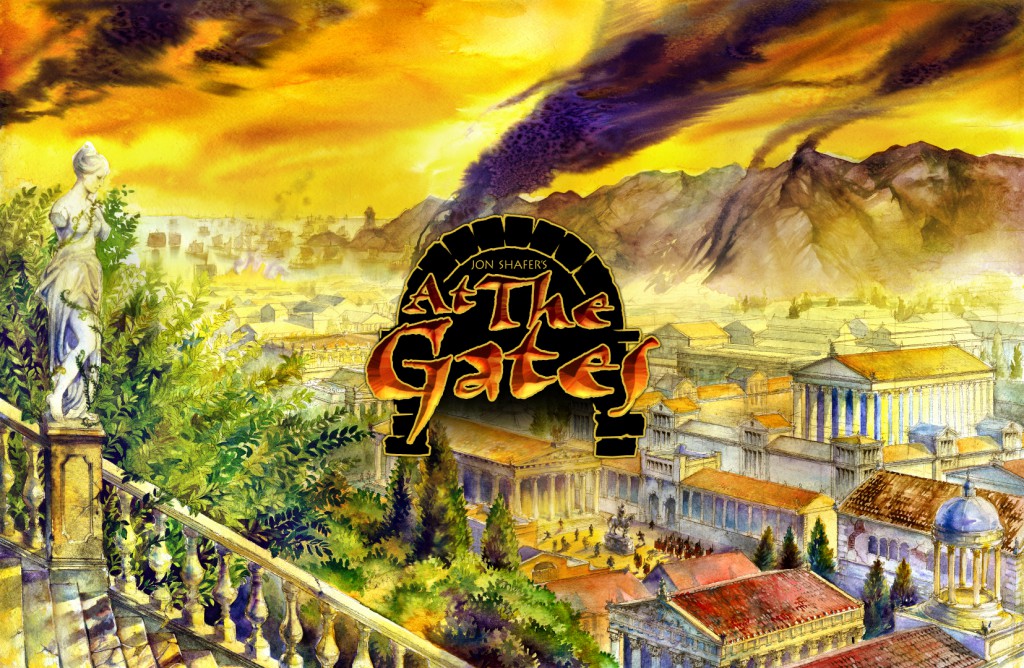
E: So wait, Romans get weaker throughout the game? That seems to be the opposite of ramping up challenge…
J: The Romans do get weaker over time, but it’s more a case of them moving from an insurmountable superpower to a foe of equal strength. They remain a real threat through the game. The challenge comes from a variety of angles really. Since the map is continually changing throughout the game, the player cannot hunker down and stay put like in Civilization. You are constantly adapting your strategy for both military and domestic purposes. Populations and soldiers require food which comes either from farms or pillaging. Farms produce nothing in the winter, so the player must plan for this. Further, there are supply chains that need to be maintained so that resources flow from the camp to the army. Military strategy is also a case of adaptation as random events occur to the Romans which can allow for opportunities. The changing map also can open up new possibilities, for example, when a river freezes over in the winter and your army is now able to cross.
E: Are all the different groups playable?
J: Never the Romans! The player chooses from eight different tribes of barbarians. The original idea came out of a conversation I had with a friend who was making a scenario about the Fall of Rome. In his scenario, you played the Romans and had to choose penalties to take on in order to mimic the fall of the Empire. I thought it was a really interesting idea, and at the time I was also listening to the History of Rome podcast. Plus, I’d had an idea in my head bouncing around for a long time, wanting to make a strategy game where the map changed over time. So those three came together and coalesced into At the Gates. It just didn’t make sense to me to play the Romans at this time. They are just trying to keep their economy going and survive. That could be a really interesting game, but it’s not this game. This is a game about starting small and adapting to circumstances to become great. Plus, this period of history is typically represented from one side, and I wanted to do something new.
E: Are the barbarian groups differentiated in some way? I think of the Barbarian Invasion expansion to Rome: Total War in which the barbarian groups all had different military units and abilities.
J: We do have a similar feature in At the Gates. The Huns, for example, will have a much stronger focus on mounted troops than other groups. Also, Huns have to move more compared to other tribes. The Goths can settle their camps down in between movement, but the Huns are nearly constantly on the move. In gameplay terms, this means they may not even be able to have farms.
The Romans are also differentiated. There are two factions, the East and West, and both develop (or decline, rather) individually throughout the game.
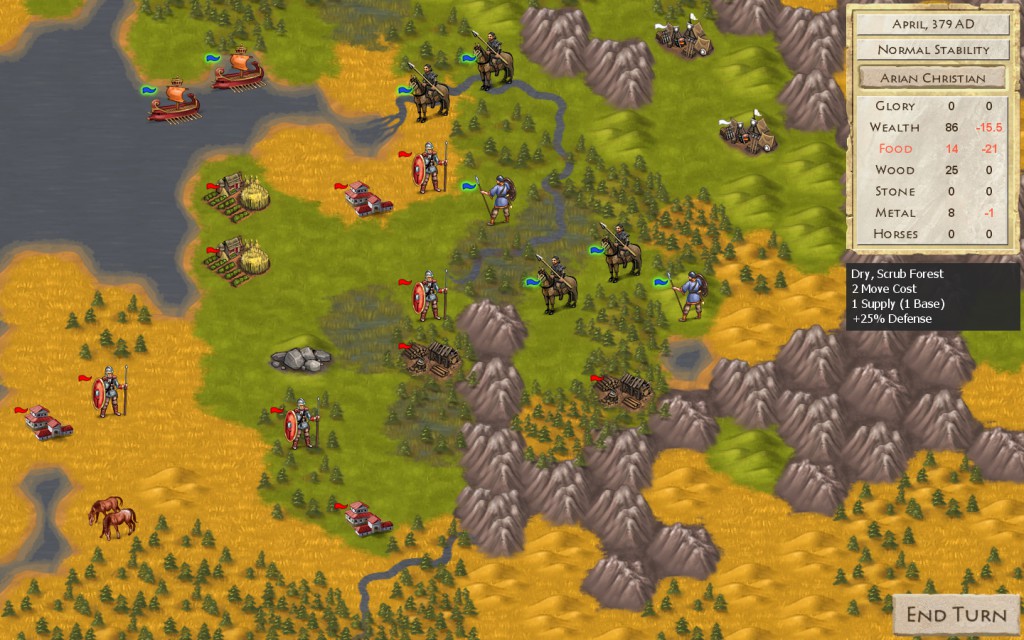
E: How do Barbarians and Romans interact?
J: I wanted to represent Romanization but also give players an obvious form of progression. In Civilization, there is the Tech Tree but that is much less historical for this period. People simply weren’t discovering a great deal during this time. So instead, we have a system of Romanization perks. Players can complete quests for the Romans or capture their cities in order to obtain a Romanization perk. These are similar to technologies – they allow you to build boats, build siege weapons, improve farms, etc. – but it captures the sense that as the barbarians overtake the Romans, they also become more like them.
E: Is there a diplomacy system in the game?
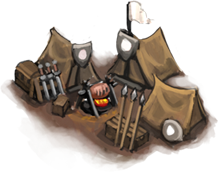
J: Absolutely. Leaders of the tribes and the Romans all have quantifiable relationships with the player depending on actions throughout the game. There are a few factors that impact relationships, one of which is Religion. Each leader has a faith they begin with, and it serves as a potential link or divide between other leaders. Currently, the game has Nicene or Arian Christianity and Paganism, but we hope to develop that further in the coming months.
E: So since there is a Religion system in place, is conversion potentially a strategic goal for the player?
J: It can be, but it is purely diplomatic. Whereas in Civ 4, you had missionaries actually converting people, in At the Gates, it’s represented as a more personal decision. What religion am I, what religion is he? Do I want to convert to make him like me more or will that damage other relationships too much?
E: You mentioned quests earlier. How does that play into diplomacy?
J: Leaders will have requests that you can take care of for approval rating. So, for example, they may desire a certain amount of food because they’re low on that resource. If you provide it, you get a large bonus to approval.
E: So why would I want to give him food as opposed to just let him starve to death?
J: So, sometimes it might be best to let him starve. But, perhaps based on geography, he has a large stockpile of metal, a resource you’re lacking. If you let him starve, the metal he had stockpiled will simply disappear with him. Or perhaps, you want his help. You can form alliances and collaborate against either the Romans or other tribes.
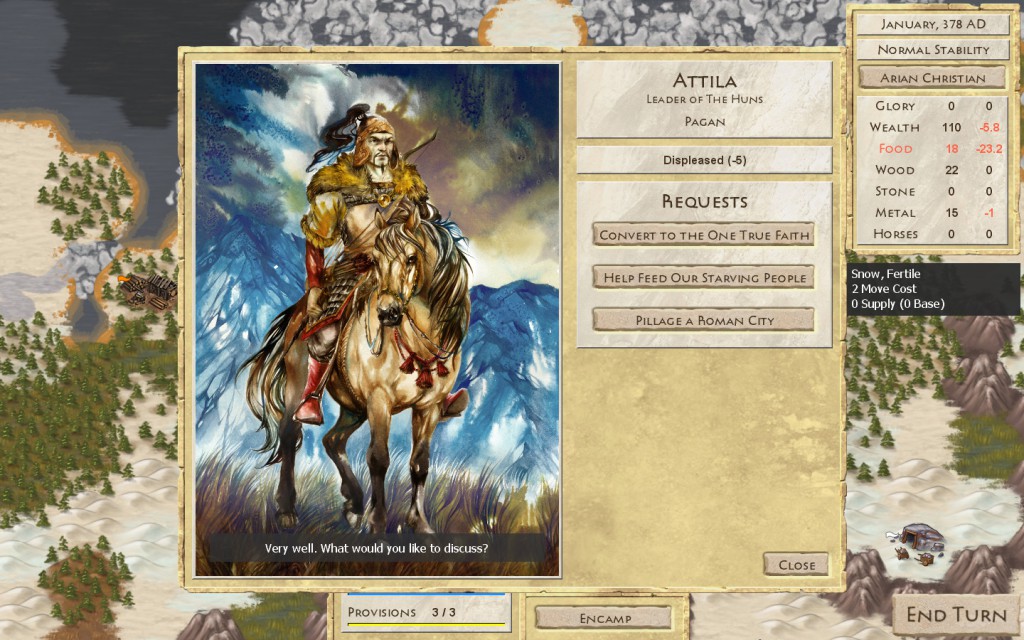
E: What about politics and government – are those represented at all?
J: At one time, there was a system of social classes in the game in groups of Farmers, Clergy, and Warriors. The player had to micro-manage the relationships among those groups. I cut it out because it was becoming a dominating part of the experience. It’s not a game about managing social classes; it’s a game about leading a barbarian tribe. Following resources was a main historical reason for doing what they did. Social classes were there, but not at the same level of significance.
There are however Roman emperors that change throughout the game. While the player remains Attila or whoever throughout, emperors will change, and the game attempts to model some of the extreme political changes in the empire through this system. Various events related to assassinations and coups can offer players opportunities for attack.
E: Do the different emperors behave differently toward the player?
Well, we haven’t worked out exactly how artwork will represent the different Roman leaders, but in terms of diplomacy yes. You may build favour with one emperor, but then he dies, and someone else takes over. You now have to adapt to this new leader and potentially adjust your strategies accordingly. We want the player to be constantly adapting.
E: So there are two Roman factions. Can you ally with one against the other?
Yes. They will have the propensity to work together more often than not, but in some cases they will turn against each other. Historically, both sides of the Empire converted to Nicene Christianity very quickly, but that doesn’t necessarily have to be true in the game, in which case you can use religion against one of them.
There are also random events that will happen to the Romans alone. For example, a plague may come in and cause problems in one of the factions, temporarily weakening them and giving the player a window of opportunity.
E: Will the Romans becomes aggressive toward you or are they merely a target?
J: Depending on your relationship with them, yes, they can. Perhaps you convert to non-Christianity and then you ally with someone who is already on their bad side, they may decide you are too much of a problem and come after you.
E: Are there any peaceful win conditions or are the other tribes and Romans merely obstacles on the way to domination?
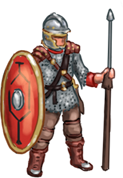
J: No, it’s really a competitive atmosphere, and not only is a diplomatic win for example not an option in the game, it’s also not really possible. You may be able to have high relations with many tribes, but that would really only be possible by giving away all your resources. You would then be weak and starving, though everyone would love you.
E: So underwritten in this domination narrative, is there an underlying notion of inevitability? Are you trying to make a point about history, about the rise and fall of empire?
J: Yes. This is where the point that this game is about history comes into play. I want to model the incremental fall of Empire, because Rome didn’t simply fall one day and the Empire was over as may be a commonly held idea but one that is very incorrect. It was gradual and complex. But I’m also trying to create an interesting play experience which also means delivering on players’ expectations about the period. The barbarians are coming; civilization is collapsing. There’s no way to prevent that.
One of my perspectives on history is that yes, there is a certain inevitability about everything. People will come and go; empires will rise and fall. There’s no way to prevent that. That’s simply the nature of everything. The Roman Empire was going to fall eventually somehow whether it was running out of food, being conquered by the barbarians, civil war or something else. There is always something that will happen in history that shifts things into the next phase. Nothing is static; everything is evolving.
E: This is very different from Civ in which empires never fall unless you go out of your way to eliminate them. They do in fact last forever. Is this project a more pessimistic or realistic reaction to that more fantastical representation?
J: Well, I wouldn’t characterize it that way. The story of Civilization is different from the story of the fall of the Roman Empire, and this is the story I am interested in. The gameplay mechanics need to match that narrative theme. So if I were making a game about civilization, I would make one with similar gameplay to what Civilization in fact has. But for this game, I think the different arc and the shifting map are necessary gameplay features to tell this story. It’s not an educational game or a historical game. It’s a game based on history. Though of course, I always have the dual goal of being entertaining and also hopefully encouraging players to think more about the history as well.
E: As a trained historian, how do you reconcile this loose relationship to facts with the high value typically placed on accuracy?
J: With history, you never really know the facts. Even if you were there, you didn’t know the facts. Even if you’re the main character, you don’t know. Whatever it is, everything we create is an interpretation of some sort. So, trying to be accurate doesn’t really make sense. You can get closer and add more detail, but it will never be fully correct. First and foremost, I am a game designer so I want to deliver an experience that is entertaining. Sometimes this means reality takes a back seat to whatever makes good gameplay. Take the example of leaders dying. You just don’t have to worry about that in Civ or At the Gates. If you’re playing one of these games and your character dies five turns in, that’s not a very great play experience. Some things in life are just not worth modeling, especially those that are outside the player’s control.
E: Well, Jon, it’s been a pleasure speaking with you about At the Gates. When can we expect to see it released?
J: We are shooting for mid-2014. Right now though, you can check out the website and the Kickstarter will go live sometime on February 6th.
E: Terrific! Can’t wait to play it.
***
Click the link below to hear Jon and the rest of the Conifer team talk about the making of the game!
